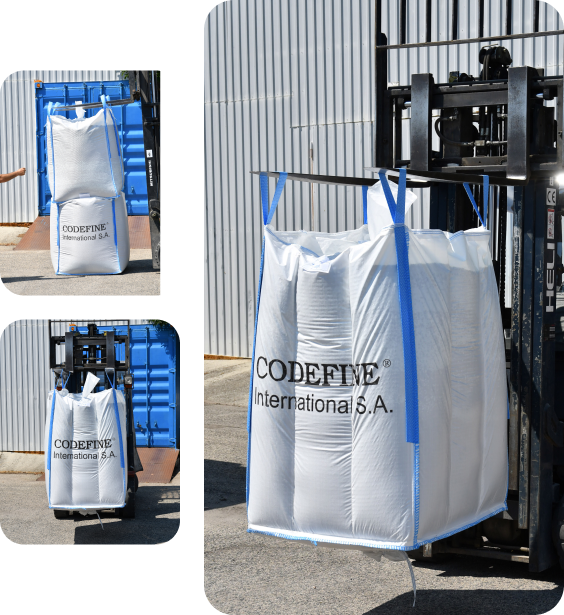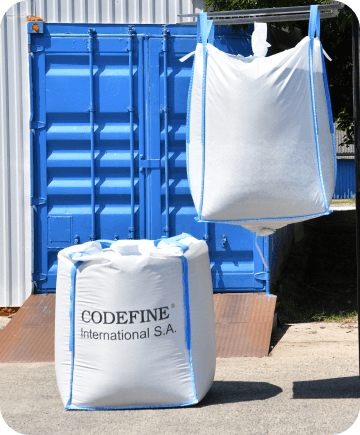Home » Posts Page » Industry » Warehouse Safety Tips: How to Safely Handle and Store Bulk Bags

Not sure where to start with bulk bag handling? Below are some best practices to observe when handling bulk bags to ensure optimal levels of safety are observed.
For optimized warehouse efficiency and safety, you’ll want to be using proper lifting equipment to handle bulk bags. Forklifts, cranes, and hoists can all be used for bulk bag handling, with certain types of machinery better suited for some environments than others. Before using any lifting equipment, make sure it’s been designed with bulk bags in mind. Weight capacities need to be checked to ensure machinery can safely lift bulk bags, while bags also need to feature certified lifting loops and attachments if they’re to be lifted safely.
When lifting bulk bags, every loop should be used to ensure optimal levels of safety. Only one hook per loop should be used. If you use multiple loops on a single hook, you run the risk of tears and bags falling from lifting equipment when suspended. Loops should also be lifted vertically, rather than laterally, as this can lead to damage.
Workers should also steer clear of bags when they are suspended. If the area around a suspended bag isn’t kept clear, there’s a very real threat of injury or death. When in transit, bags need to be sufficiently secured. This renders them safer to transport, but also prevents spillage and damage. Finally, bags should only ever be lifted with proper lifting equipment. They should never be manually or mechanically pushed or dragged across the ground.
Safe Working Load (SWL) is something you’re going to want to take notice of if you intend to handle bulk bags safely. Rated capacities and SWL offer clear guidance on how much weight a bulk bag can comfortably accommodate. Overloading bags beyond these limits significantly increases the chance of breakage or an accident. Even weight distribution is also important. When filling and loading bags, make sure the material is distributed as evenly as possible throughout the interior of the container.
Are you keen to enhance the health and safety credentials of your warehouse? Safe storage of bulk bags is a good place to start. Below are just a few pointers to bear in mind when storing bulk bags in your warehouse environment.
Although packaging solutions like bulk bags are incredibly hard-wearing, they are at risk of degradation if not kept in ideal conditions. When storing bulk bags, avoid doing so in environments that experience temperature extremes. Significantly high and low temperatures can cause damage to bulk bags, rendering them unfit for purpose. The same applies to moisture, which is why humidity levels need to be kept in check when storing bulk bags
Fortunately, there are many ways to mitigate the impact of environmental factors. Properly ventilated warehouse environments can help negate humidity levels, preventing moisture damage. Bags should also be kept out of direct sunlight. This not only prevents damage from UV rays, but also protects containers against damage from high temperatures.
Although packaging solutions like bulk bags are incredibly hard-wearing, they are at risk of degradation if not kept in ideal conditions. When storing bulk bags, avoid doing so in environments that experience temperature extremes. Significantly high and low temperatures can cause damage to bulk bags, rendering them unfit for purpose. The same applies to moisture, which is why humidity levels need to be kept in check when storing bulk bags
Fortunately, there are many ways to mitigate the impact of environmental factors. Properly ventilated warehouse environments can help negate humidity levels, preventing moisture damage. Bags should also be kept out of direct sunlight. This not only prevents damage from UV rays, but also protects containers against damage from high temperatures.
When storing bulk bags, you can choose between stacking and racking. Generally speaking, stacking is cheaper and more straightforward. However, basic guidelines need to be observed to stack safely.
Firstly, it’s worth remembering that not all bulk bags are stackable. If the bags you use are stackable, they should only be stacked using the supported or pyramid method. The supported method involves placing filled bags against two retaining walls, while the pyramid method sees one bag placed on a base of four bags beneath it. You’ll also need to take stacking height recommendations into account. Ideally, bags should never be stacked to a height of more than four bags.
Sometimes, racking might be the preferred option for storing bulk bags. Pallet racking allows you to make maximum use of vertical space, making it the preferred choice if you’re looking to optimize a small warehouse. Racking also allows you to access bulk bags directly, without having to disturb bags underneath or above them.
It’s also the best solution if you’re using bulk bags to store bulky items or particularly heavy loads. These cumbersome contents can be hard to stack safely using the supported and pyramid methods. In short, racking allows for maximum stability, making it the only choice if you’re serious about safety.
Even in a secure warehouse, it’s important to take extra steps to protect bulk bags and their contents against contamination and damage. Pallets can provide a barrier between bags and the ground, helping stave off pests and ground moisture. Protective covers are also effective at pest control, while keeping humidity and condensation at bay.
To prevent damage to bulk bags like tears, ensure they’re being stored away from sharp objects. Bulk bags also need to be kept clear of any hazardous materials they’re not being used to store. This way, the structural integrity of containers remains intact, preventing material spillage and potential accidents.
When handling bulk bags, the average warehouse setting presents many safety hazards. Falling bags are one such worry, with the potential to cause injury or a fatality. Improper lifting can lead to similar consequences, while structural failures of racking can lead to significant damage and pose a serious risk to life.
Fortunately, offsetting these risks is surprisingly simple. Instilling health and safety best practices in your workforce is one of the easiest ways to avoid accidents and injuries. When lifting and suspending filled bulk bags, make sure the work area is kept clear, using signage to highlight the message.
What’s more, you also need to ensure your employees are fully versed on how to use lifting equipment and proper lifting techniques. Finally, commit to regular inspections of racking to check for signs of damage and wear and tear. Ensure any repairs are carried out quickly to avoid collapse and eliminate risk to your workers.
Warehouse safety involves more than simply identifying and remedying risk factors. It’s a legal requirement that every business needs to take seriously. Organizations like the Occupational Safety and Health Administration (OSHA) outline a rigorous set of guidelines for workplace safety, establishing standards for everything from material handling to forklift operation. By observing these guidelines and adhering to other regulations, you’ll not only enhance workplace safety but also avoid liability should the worst happen.
Bulk bags make a welcome addition to any warehouse operation. Durable, versatile, and incredibly cost-effective, it’s little wonder that they’re such a popular choice of industrial packaging. However, to use them safely, you’ll need to observe basic handling guidelines, use proper lifting equipment, and ensure bags are stored correctly when not in use.
Searching for high-quality bulk bags to incorporate into your operation? At Codefine, you’ll find an impressive selection of premium bulk bags at affordable prices. Looking for an alternative packing solution? Why not explore our full range today? Alternatively, drop us a message to discuss your requirements in more detail.
